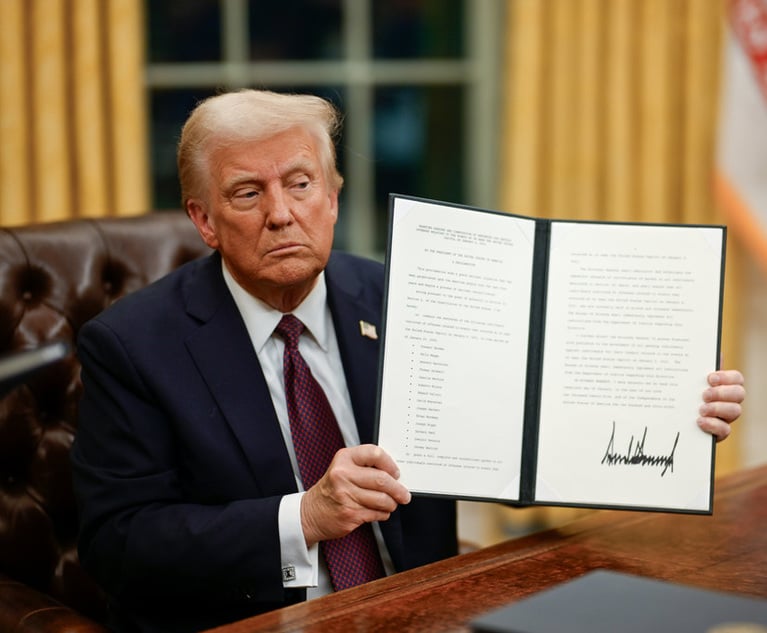Tortious Interference Case Highlights Statute of Limitations Challenge
In 'S.A.R.L. Galerie Enrico Navarra v. Marlborough Gallery', the First Department agreed with the Supreme Court that plaintiff's claims for tortious interference with contract and aiding and abetting tortious interference with contract had not expired as a matter of law, because all of the elements of the claims had materialized before the statute of limitations had run its course.
May 11, 2021 at 11:10 AM
7 minute read
 When does the statute of limitations start to run on a tortious interference with contract claim when the breach occurred somewhere on a spectrum of increasingly breach-like behavior? The Appellate Division, First Department, tackled that question in a May 6 decision concerning a long-running dispute involving the work of world-renowned Chinese-French artist Chu Teh-Chun. In S.A.R.L. Galerie Enrico Navarra v. Marlborough Gallery, the First Department agreed with the Supreme Court that plaintiff's claims for tortious interference with contract and aiding and abetting tortious interference with contract had not expired as a matter of law, because all of the elements of the claims had materialized before the statute of limitations had run its course. The case highlights the challenges of determining when a breach of contract occurred, and the tension between statutes of limitations and the rights of an injured party to bring a claim.
When does the statute of limitations start to run on a tortious interference with contract claim when the breach occurred somewhere on a spectrum of increasingly breach-like behavior? The Appellate Division, First Department, tackled that question in a May 6 decision concerning a long-running dispute involving the work of world-renowned Chinese-French artist Chu Teh-Chun. In S.A.R.L. Galerie Enrico Navarra v. Marlborough Gallery, the First Department agreed with the Supreme Court that plaintiff's claims for tortious interference with contract and aiding and abetting tortious interference with contract had not expired as a matter of law, because all of the elements of the claims had materialized before the statute of limitations had run its course. The case highlights the challenges of determining when a breach of contract occurred, and the tension between statutes of limitations and the rights of an injured party to bring a claim.
Background
The facts underlying this case go back to 2003, when the plaintiff, Galerie Enrico Navarra (Navarra), contracted with a non-party, the now dead abstract artist Chu Teh-Chun (Chu). Under their agreement, Chu would design 24 ceramic plates, and Navarra would support Chu by, among other things, paying for the production of the plates, helping to promote the sale of the plates, and, ultimately, selling the plates.
Allegedly because of tortious interference by the defendant, Marlborough Gallery (Marlborough), the relationship between Navarra and Chu soured over the next few years, and in February 2007 Chu first sent a cease-and-desist letter to Navarra claiming that the gallery had breached their agreement. Then, two months later, Chu sued Navarra on the same grounds in France. In May 2008, Chu took additional action against Navarra, first by sending a letter to Christie's in Hong Kong, casting doubt on the authenticity of plates that Navarra had arranged to be auctioned there, and demanding that Christie's withdraw the plates from auction. Then, in October 2008, an advertisement appeared in a French art magazine announcing that the plates that Navarra was offering for sale were not authentic.
This content has been archived. It is available through our partners, LexisNexis® and Bloomberg Law.
To view this content, please continue to their sites.
Not a Lexis Subscriber?
Subscribe Now
Not a Bloomberg Law Subscriber?
Subscribe Now
NOT FOR REPRINT
© 2025 ALM Global, LLC, All Rights Reserved. Request academic re-use from www.copyright.com. All other uses, submit a request to [email protected]. For more information visit Asset & Logo Licensing.
You Might Like
View All
'A Shock to the System’: Some Government Attorneys Are Forced Out, While Others Weigh Job Options
7 minute read
'Serious Legal Errors'?: Rival League May Appeal Following Dismissal of Soccer Antitrust Case
6 minute read
How Some Elite Law Firms Are Growing Equity Partner Ranks Faster Than Others
4 minute read
Trending Stories
- 1States Accuse Trump of Thwarting Court's Funding Restoration Order
- 2Microsoft Becomes Latest Tech Company to Face Claims of Stealing Marketing Commissions From Influencers
- 3Coral Gables Attorney Busted for Stalking Lawyer
- 4Trump's DOJ Delays Releasing Jan. 6 FBI Agents List Under Consent Order
- 5Securities Report Says That 2024 Settlements Passed a Total of $5.2B
Who Got The Work
J. Brugh Lower of Gibbons has entered an appearance for industrial equipment supplier Devco Corporation in a pending trademark infringement lawsuit. The suit, accusing the defendant of selling knock-off Graco products, was filed Dec. 18 in New Jersey District Court by Rivkin Radler on behalf of Graco Inc. and Graco Minnesota. The case, assigned to U.S. District Judge Zahid N. Quraishi, is 3:24-cv-11294, Graco Inc. et al v. Devco Corporation.
Who Got The Work
Rebecca Maller-Stein and Kent A. Yalowitz of Arnold & Porter Kaye Scholer have entered their appearances for Hanaco Venture Capital and its executives, Lior Prosor and David Frankel, in a pending securities lawsuit. The action, filed on Dec. 24 in New York Southern District Court by Zell, Aron & Co. on behalf of Goldeneye Advisors, accuses the defendants of negligently and fraudulently managing the plaintiff's $1 million investment. The case, assigned to U.S. District Judge Vernon S. Broderick, is 1:24-cv-09918, Goldeneye Advisors, LLC v. Hanaco Venture Capital, Ltd. et al.
Who Got The Work
Attorneys from A&O Shearman has stepped in as defense counsel for Toronto-Dominion Bank and other defendants in a pending securities class action. The suit, filed Dec. 11 in New York Southern District Court by Bleichmar Fonti & Auld, accuses the defendants of concealing the bank's 'pervasive' deficiencies in regards to its compliance with the Bank Secrecy Act and the quality of its anti-money laundering controls. The case, assigned to U.S. District Judge Arun Subramanian, is 1:24-cv-09445, Gonzalez v. The Toronto-Dominion Bank et al.
Who Got The Work
Crown Castle International, a Pennsylvania company providing shared communications infrastructure, has turned to Luke D. Wolf of Gordon Rees Scully Mansukhani to fend off a pending breach-of-contract lawsuit. The court action, filed Nov. 25 in Michigan Eastern District Court by Hooper Hathaway PC on behalf of The Town Residences LLC, accuses Crown Castle of failing to transfer approximately $30,000 in utility payments from T-Mobile in breach of a roof-top lease and assignment agreement. The case, assigned to U.S. District Judge Susan K. Declercq, is 2:24-cv-13131, The Town Residences LLC v. T-Mobile US, Inc. et al.
Who Got The Work
Wilfred P. Coronato and Daniel M. Schwartz of McCarter & English have stepped in as defense counsel to Electrolux Home Products Inc. in a pending product liability lawsuit. The court action, filed Nov. 26 in New York Eastern District Court by Poulos Lopiccolo PC and Nagel Rice LLP on behalf of David Stern, alleges that the defendant's refrigerators’ drawers and shelving repeatedly break and fall apart within months after purchase. The case, assigned to U.S. District Judge Joan M. Azrack, is 2:24-cv-08204, Stern v. Electrolux Home Products, Inc.
Featured Firms
Law Offices of Gary Martin Hays & Associates, P.C.
(470) 294-1674
Law Offices of Mark E. Salomone
(857) 444-6468
Smith & Hassler
(713) 739-1250






